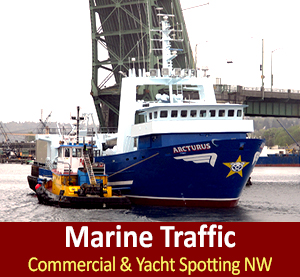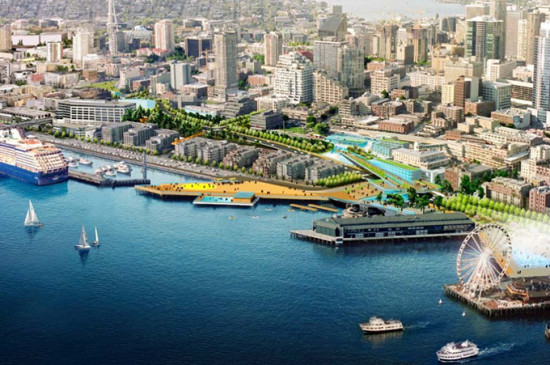 The Elliott Bay Seawall is Getting an Overhaul
The Elliott Bay Seawall is Getting an Overhaul
The Elliott Bay seawall in Seattle is being rebuilt- more than 7000 total feet of it! This wall prevents the sea from eroding the area of land that the sea is near. This part of Elliott Bay historically included habitats like mudflats and gently sloping beaches that are important to commercial and recreational fisheries, and threatened and endangered species. The new seawall will work to improve essential fish habitat, help protect threatened species, and restore ecosystem function along this critical stretch of Puget Sound shoreline, demonstrating that a healthy fish habitat and vibrant waterfront communities can truly exist together.
“This project is a role model – both protecting critical infrastructure and providing important fish habitat,” said Jessica Murphy, Seattle’s project manager. The project also meets current seismic standards and will last more than 75 years, serving as the foundation for projects that will transform Seattle’s future waterfront.
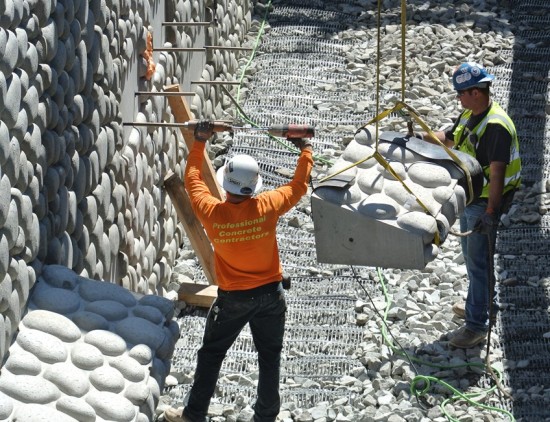 Workers Installing Textured Seawall for Better Marine Habitation
Workers Installing Textured Seawall for Better Marine Habitation
The seawall running along the Elliott Bay waterfront in Seattle, Washington was built between 1916 and 1936 out of timbers and concrete. It created a deep-water port and provided a level corridor for railroads. Before the seawall was installed, the Elliott Bay shoreline consisted of mudflats, gently sloping beaches, and shallow intertidal waters. Salmon used this shallow intertidal habitat as a migratory and feeding corridor on their way to the ocean. The shallow waters also provided refuge from predators and a food supply for many fish. This vital habitat disappeared when the original seawall was built, and when the shallow intertidal zone behind it was filled to create land. Like many projects of the time, it failed to take into account the relationship between man and nature and the seawall project looks to mutually benefit everyone a bit more equally.
The seawall has been deteriorating since it was built more than 70 years ago. In 2001, seawall was further damaged by the Nisqually earthquake, and upon the city’s safety investigation afterward, they found that it was in much need of repair. Cracks allowed salt water and gribbles (tiny marine crustaceans) inside the structure. The salt water carried the soil beneath the seawall away, creating hollow areas in danger of caving in and the gribbles have eaten away the timber that supports the structure.
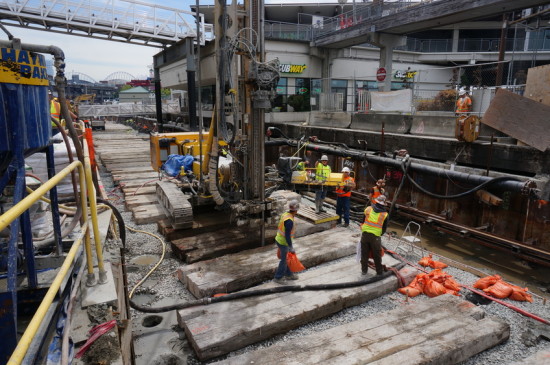 The Seawall Support Structure Was in Critical Need of Repairs
The Seawall Support Structure Was in Critical Need of Repairs
The City of Seattle worked with NOAA Fisheries, the U.S. Fish and Wildlife Service, tribes, and other agencies on a new plan for the seawall. The plan incorporated innovative design features so that the new seawall will recreate conditions of a natural shoreline. Puget Sound Chinook salmon, coho salmon, chum salmon, sockeye salmon, pink salmon, steelhead, cutthroat trout, and bull trout can be found in habitats in and around the Elliott Bay Seawall Project. Young Chinook salmon, pink salmon, and chum salmon are seen migrating past the seawall in the spring and summer months. In 1999, Puget Sound Chinook salmon and bull trout were listed as “threatened” under the Endangered Species Act. In 2007, Puget Sound steelhead were listed as “threatened.”
NOAA Fisheries works with other federal and state agencies to help economically important infrastructure projects, like the Elliott Bay Seawall, move forward in a way that minimizes impacts to the habitats that support commercial and recreational fisheries and avoids damage to habitats for threatened and endangered species. Essential fish habitat includes all types of aquatic habitat – like wetlands, seagrasses, rocky reefs, and rivers—where fish spawn, breed, feed, or grow to adulthood. This area of Puget Sound includes essential fish habitat for coho salmon, pink salmon, lingcod, greenling, rockfish, and flatfish.
 Coho Salmon Calls Elliott Bay Home
Coho Salmon Calls Elliott Bay Home
NOAA Fisheries and the U.S. Fish and Wildlife Service worked with the Army Corps of Engineers on this project to make sure essential fish habitat, endangered and threatened species – and their critical habitats – were protected. The new seawall has been moved back from the existing location, providing an additional 10-15 feet for habitat. New habitat innovations on the wall will create a continuous intertidal migratory corridor for salmon, and habitat for many other species of fish, invertebrates, birds, and insects.
A similar project was built in 2007 at nearby Olympic Sculpture Park. After construction, rockfish – primarily black rockfish – were spotted in the area. That’s huge, and the Elliott Bay seawall will bear host to more species that haven’t been seen in decades.
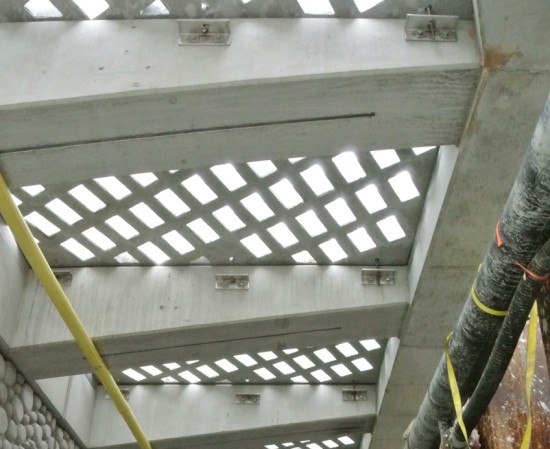 The Intertidal Habitat Bench That’s Part of the New Seawall
The Intertidal Habitat Bench That’s Part of the New Seawall
Salmon, other fish, and invertebrates depend on shallow water habitats for feeding, breeding, growing, migrating, and refuge from predators. To restore some of this lost habitat, this project will install a 10- to 30-foot wide intertidal habitat bench spanning the length of the new seawall. The bench will have a gravelly surface to which invertebrates and plant life can attach. It will also be a hiding place for many species, and provide fish with rearing habitats and increased prey. It will also provide a continuous nearshore migratory corridor along the seawall for migrating salmon.
Other innovative habitat features of the seawall will:
- provide habitat to invertebrates like urchins
- provide areas for mussels, barnacles, and algae to attach and become food for fish and other wildlife
- increase floating kelp distribution and density
- improve habitat for the prey of many marine species
- provide a continuous intertidal migratory corridor for juvenile salmon
- improve water quality along the face of the seawall
After the project is complete, the habitat features will be monitored for up to 10 years to ensure they are functioning as expected.
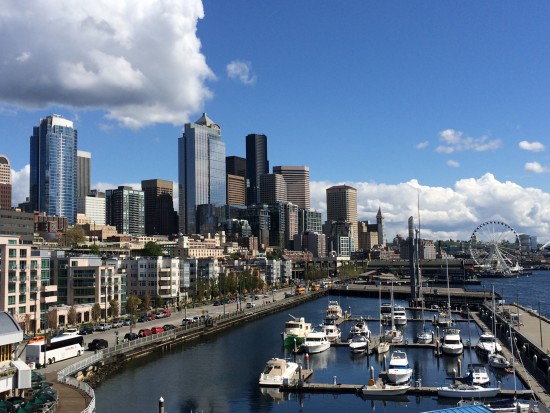 Nature is Coming Back to Elliott Bay
Nature is Coming Back to Elliott Bay




